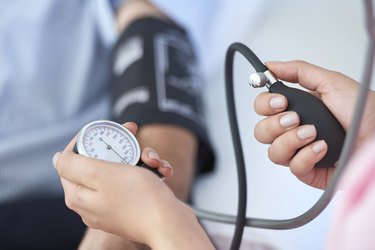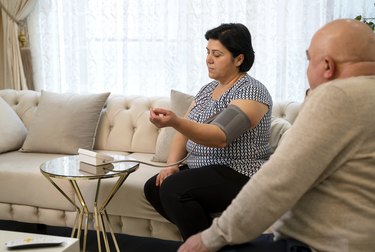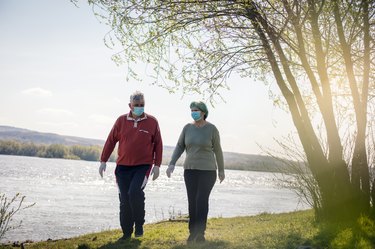
Your blood pressure isn't just a number on your chart at the doctor's office — it's also one of the most important indicators of how healthy you are and how healthy you are likely to be in the future.
But what is blood pressure, exactly? In the simplest terms, it's the measure of how hard your blood is pressing on the walls of your arteries as your heart pushes it through your body, according to the American College of Cardiology (ACC).
"Blood pressure is the driving force for delivering blood to all of our organs," Karol Watson, MD, PhD, spokesperson for the ACC and co-director of the UCLA Program in Preventive Cardiology, tells LIVESTRONG.com.
Dr. Watson likens it to the pressure of a garden hose: You don't want it to be a trickle, but you also don't want it on full-blown, fire-hose level. "You need a nice, steady stream of blood," she says.
Here's what else you need to know about this key measure of your health.
Why Is Blood Pressure Important?

That steady stream of blood delivers oxygen and other nutrients that all the different parts of your body need to survive.
"Blood pressure is critical," says Michael Blaha, MD, MPH, professor of medicine and director of clinical research at Johns Hopkins University's Ciccarone Center for the Prevention of Cardiovascular Disease, adding that blood pressure needs to be high enough to sustain your everyday functions. "There is a blood pressure below which you can't live."
On the other hand, uncontrolled high blood pressure — also called hypertension — can kill you over time by damaging your blood vessels and organs, according to the ACC.
Systolic vs. Diastolic Blood Pressure
Your blood pressure measurement is given as two numbers — a larger number "over" a smaller number, like "120 over 80" or "120/80."
The first, higher number is called your systolic blood pressure, which measures the pressure when your heart is actually beating or pumping, Dr. Blaha says.
The second, lower number is your diastolic pressure. This records the pressure when your heart is resting between pumps.
"Systolic blood pressure is probably more important because it's more often uncontrolled," Dr. Watson says. Uncontrolled or high systolic blood pressure is a red flag that you're at risk for heart disease, among other things, according to the American Heart Association (AHA).
What Is a Healthy Blood Pressure Range?
According to 2017 ACC and AHA guidelines, a good, normal blood pressure reading for adults is less than 120/80 mm Hg (that's millimeters of mercury, in case you were wondering). Anything above that is considered high and may require treatment.
Any reading below 90/60 is considered low blood pressure, per the Mayo Clinic, but this is generally only a concern if it's accompanied by symptoms, such as:
- Cold, clammy, pale skin
- Rapid breathing
- Fainting
- Blurred vision
- Confusion, especially in older adults
- Nausea
- Fatigue
It's also important to note that the time of day can naturally affect your blood pressure, per the Mayo Clinic. Blood pressure tends to be lower in the morning, rises to a peak around midday and falls again during the evening and night. As a result, there's nothing to worry about if your blood pressure is normal in the morning and higher in the afternoon, as long as both readings fall into the healthy range.
But if you notice this pattern is different — for instance, your blood pressure is usually higher in the morning or you have evening blood pressure spikes — it could be a sign of uncontrolled hypertension, per the Mayo Clinic. It may also be a symptom of another underlying medical condition, such as:
- Sleep apnea
- Kidney disease
- Diabetes
- Thyroid disease
- Nervous system disorder
Blood Pressure Chart
Blood Pressure Category | Blood Pressure Range |
Normal | Less than 120/80 |
Elevated | Systolic between 120-129 and diastolic less than 80 |
Stage 1 Hypertension (High Blood Pressure) | Systolic between 130-139 or diastolic between 80-89 |
Stage 2 Hypertension (High Blood Pressure) | Systolic at least 140 or diastolic at least 90 |
Hypertensive Crisis (may require hospitalization) | Systolic over 180 and/or diastolic over 120 |
Factors That Affect Blood Pressure

Many different factors can influence your blood pressure levels, per the Mayo Clinic and National Heart, Lung and Blood Institute (NHLBI), including:
- Age (older individuals are more likely to have high blood pressure)
- Sex (people assigned male at birth are more likely to have hypertension until age 45; people assigned female at birth are more likely to have it after age 65)
- Family history
- Physical activity
- Body mass index
- Smoking or chewing tobacco
- Diet (especially how much salt you eat)
- Diabetes
- Kidney disease
- Race (African-Americans have a higher risk of developing hypertension)
- Stress
- Potassium in your diet
- Sleep apnea
- Disrupted sleep patterns or not getting enough sleep
- Pregnancy
- Time of day
- Caffeine
- Certain medications like antidepressants, decongestants, hormonal birth control and NSAIDs such as aspirin or ibuprofen
- Overtraining, per November 2019 research in The Journal of Strength and Conditioning Research
Is this an emergency? If you are experiencing serious medical symptoms, please see the National Library of Medicine’s list of signs you need emergency medical attention or call 911.


